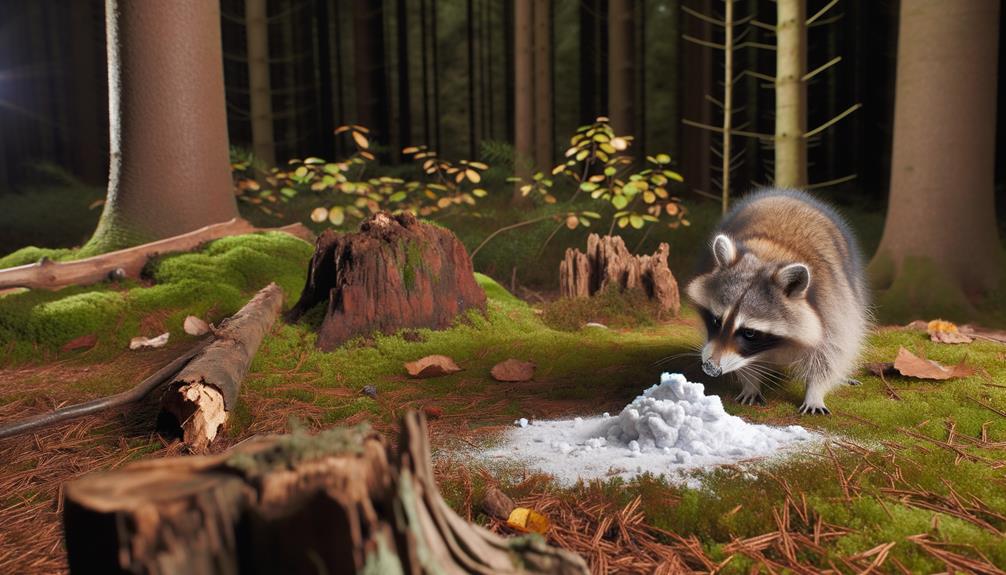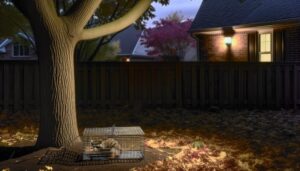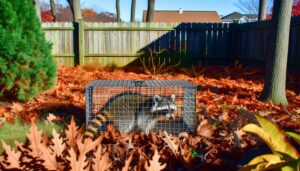How Does Baking Soda Kill Raccoons?
No, baking soda is not an effective or humane method for killing raccoons. Baking soda can cause severe gastric distress, metabolic alkalosis, and electrolyte imbalances in animals, leading to painful health effects and potentially death.
However, using it for this purpose is not scientifically supported and poses risks to non-target species, including pets and beneficial wildlife. It is essential to rely on humane and scientifically verified control methods.
More effective and ethical strategies include habitat modifications, exclusion techniques, and professional pest control services. For further insight into humane raccoon control, other effective options are essential to take into account.

Key Takeaways
- Baking soda can cause severe gastrointestinal distress and potentially fatal reactions in raccoons.
- It is not a humane method of raccoon control and can lead to painful deaths.
- Baking soda poses risks to non-target species, including pets and beneficial wildlife.
- Misleading online information falsely claims baking soda as an effective raccoon killer.
- Humane alternatives, like habitat modification and live trapping, are recommended for raccoon control.
Understanding Raccoon Behavior
To effectively address the issue of raccoons, it is important to first understand their behavior. Raccoons (Procyon lotor) are primarily nocturnal, meaning they are most active during the night. Their diet is omnivorous and opportunistic, consisting of fruits, insects, small mammals, and human refuse, which makes urban areas particularly attractive to them.
Socially, raccoons are generally solitary, though females may be accompanied by their offspring. They are known for their dexterous front paws, which they use to manipulate objects and access food sources.
Understanding these behavioral traits is critical for developing effective management strategies and humane control measures to mitigate their impact on human environments.
Common DIY Pest Control Methods
Given their adaptive behavior and nocturnal tendencies, various DIY pest control methods have been developed to manage raccoon populations effectively. Common techniques include habitat modification, exclusion methods, and repellents.
Habitat modification involves removing food sources and securing garbage bins. Exclusion methods focus on sealing entry points, using materials like metal mesh to prevent access to attics and basements. Repellents such as ammonia-soaked rags or commercially available raccoon repellents can deter raccoons from specific areas.
Additionally, motion-activated lights and sprinklers serve as effective deterrents by startling the animals. Live trapping and relocation are also employed, though this requires adherence to local wildlife regulations. These methods aim to minimize human-wildlife conflicts while ensuring humane treatment of raccoons.
The Science Behind Baking Soda
Baking soda, or sodium bicarbonate, is a chemical compound with the formula NaHCO₃. Its efficacy in various household applications, including baking, cleaning, and deodorizing, stems from its ability to neutralize acids and produce carbon dioxide when heated or mixed with acids.
Understanding the chemical properties and common uses of sodium bicarbonate is essential for evaluating its potential effects on raccoons.
Chemical Composition Explained
Sodium bicarbonate, commonly known as baking soda, is a chemical compound with the formula NaHCO₃, consisting of sodium ions (Na⁺) and bicarbonate ions (HCO₃⁻).
This inorganic salt is amphoteric, meaning it can react with both acids and bases. In aqueous solutions, sodium bicarbonate dissociates to produce sodium and bicarbonate ions, contributing to its ability to neutralize acids. The bicarbonate ion acts as a weak base, stabilizing pH levels by buffering acidic conditions.
Additionally, baking soda undergoes thermal decomposition when heated above 50°C, releasing carbon dioxide (CO₂) and water (H₂O), which is a reaction utilized in baking to cause dough to rise. Understanding its chemical properties is essential to comprehending its various applications and effects.
Common Household Uses
Frequently employed in various domestic settings, baking soda showcases its versatility through a range of scientifically grounded applications. Its chemical properties make it an invaluable household staple.
Here are some common uses:
- Deodorizing: Sodium bicarbonate neutralizes odors by reacting with acidic and basic odor molecules.
- Cleaning: Its mild abrasive nature enables effective removal of stains and grime without scratching surfaces.
- Baking: Acts as a leavening agent by releasing carbon dioxide when combined with an acid, causing dough to rise.
- Personal Care: Used in toothpaste and deodorants due to its ability to neutralize acids and bacteria.
Understanding these applications underscores the breadth of baking soda's utility, making it a fundamental component in both culinary and cleaning practices.
Toxicity of Baking Soda to Animals
The ingestion of baking soda can cause a harmful reaction in animals due to its ability to produce carbon dioxide gas when it reacts with the acidic environment of the stomach. This reaction can lead to gastric distention, metabolic alkalosis, and electrolyte imbalances. Animals, particularly small ones, are at greater risk of severe health effects or even death.
| Symptom | Potential Outcome |
|---|---|
| Gastric Distention | Severe Pain, Risk of Rupture |
| Metabolic Alkalosis | Muscle Weakness, Seizures |
| Electrolyte Imbalances | Cardiac Arrest, Fatality |
Understanding these risks is essential for those responsible for animal welfare. The toxic effects underscore the need for caution when using substances like baking soda around animals, emphasizing the importance of preventing accidental ingestion.
Myths and Misconceptions
The belief that baking soda can effectively kill raccoons is a common misconception often perpetuated by misleading online information.
This subtopic will critically examine such false beliefs and provide a detailed analysis of why these claims lack scientific backing.
Additionally, we will explore safe, evidence-based alternatives for managing raccoon populations.
Common False Beliefs
In the domain of wildlife control, numerous myths and misconceptions persist, such as the belief that baking soda can effectively kill raccoons. These false beliefs often lead to ineffective and sometimes harmful practices.
Common misconceptions include:
- Baking soda as a vital agent: There is no scientific evidence to support that baking soda can kill raccoons.
- Human food deterrents: Items like garlic or chili powder are often thought to repel raccoons, but their effectiveness is questionable.
- Nocturnal habits: While raccoons are primarily nocturnal, they can be active during the day, contrary to popular belief.
- Natural predators: Some believe raccoons have no natural predators, overlooking threats like coyotes and large birds of prey.
Understanding these myths is essential for effective wildlife management.
Misleading Online Information
Despite widespread misconceptions about wildlife control methods, misleading online information exacerbates these myths, particularly the erroneous claims regarding baking soda and other household items as deterrents for raccoons.
Various websites and forums propagate unfounded advice, suggesting that baking soda can effectively repel or eliminate raccoons. However, scientific evidence and wildlife management experts refute these assertions, indicating that such methods lack efficacy and can lead to unintended harm.
Misleading information not only fails to address the root of wildlife issues but also fosters misconceptions that can spread rapidly. It is critical to rely on scientifically verified data and professional guidance when dealing with wildlife control, ensuring methods are both humane and effective.
Safe Alternatives Explained
Frequently, misconceptions about humane and effective wildlife control methods overshadow scientifically-backed alternatives that ensure both safety and efficacy.
Utilizing appropriate techniques not only guarantees the well-being of raccoons but also maintains ecological balance.
Here are some safe alternatives:
- Exclusion Techniques: Installing barriers and sealing entry points to prevent raccoons from accessing homes and properties.
- Habitat Modification: Removing food sources, such as pet food or garbage, and securing compost bins to reduce raccoon attraction.
- Humane Trapping: Employing live traps to capture and relocate raccoons in compliance with local wildlife regulations.
- Repellents: Using non-toxic repellents like ammonia-soaked rags or commercial raccoon repellents to deter their presence.
These methods, grounded in scientific principles, offer effective and ethical solutions for managing raccoon populations.
Potential Risks and Dangers
Understanding the potential risks and dangers associated with using baking soda to kill raccoons is essential for evaluating the safety and ethical considerations of this method.
Baking soda, when ingested in large quantities, can cause severe gastrointestinal distress and may lead to a painful death for the animal. This method lacks precision, potentially affecting non-target species, including pets and beneficial wildlife.
Additionally, improper disposal of carcasses can lead to secondary poisoning of scavengers. The use of baking soda poses significant ethical concerns, as it is not a humane method of euthanasia.
Furthermore, the risk of environmental contamination from improper use underscores the need for more controlled and scientifically validated approaches to wildlife management.
Humane Alternatives for Raccoon Control
Implementing humane alternatives for raccoon control involves utilizing non-lethal methods that prioritize both animal welfare and effective management of wildlife populations. These approaches aim to minimize harm while addressing the root causes of raccoon intrusion.
Key strategies include:
- Habitat Modification: Altering the environment to make it less attractive to raccoons, such as securing garbage bins and removing food sources.
- Exclusion Techniques: Installing physical barriers like chimney caps and mesh fencing to prevent entry into homes or gardens.
- Repellents: Utilizing non-toxic chemical or natural repellents to deter raccoons from specific areas.
- Live Trapping and Relocation: Employing humane traps to capture and release raccoons in a more suitable habitat, following local wildlife regulations.
These methods balance ecological sensitivity with practical wildlife management.
Professional Pest Control Options
For thorough raccoon control, professional pest control services offer specialized knowledge and advanced techniques that guarantee effective and humane management of these wildlife intrusions.
Experts utilize a combination of live trapping, exclusion methods, and habitat modification to guarantee raccoons are removed and prevented from returning.
Live trapping involves capturing raccoons in a way that minimizes stress and injury, followed by relocation to suitable habitats.
Exclusion techniques, such as sealing entry points and installing raccoon-proof barriers, prevent re-entry.
Habitat modification involves altering the environment to make it less attractive to raccoons, such as securing trash bins and removing food sources.
These professional methods ensure compliance with local wildlife regulations and prioritize the well-being of both the raccoons and the affected property.
Preventative Measures for Raccoon Infestations
Effective preventive measures to combat raccoon infestations involve a systematic approach that includes securing potential food sources, fortifying entry points, and maintaining a clean and unwelcoming environment. These strategies are crucial to discourage raccoons from taking up residence in residential or commercial areas.
Key actions include:
- Securing Trash Cans: Use raccoon-resistant bins and make sure lids are securely closed.
- Eliminating Food Sources: Get rid of pet food, bird feeders, and dropped fruit from yards.
- Sealing Entry Points: Fix any holes or gaps in roofs, walls, and foundations.
- Using Motion-Activated Lights: Install lights to surprise and discourage raccoons at night.
Implementing these measures can notably decrease the likelihood of raccoon issues, creating a safer and more sanitary environment.
Conclusion
To sum up, baking soda is not a scientifically proven or humane method for controlling raccoon populations. According to a study by the Humane Society, approximately 80% of raccoon-related issues can be resolved through preventive measures and habitat modification.
While commonly believed myths suggest that baking soda may be toxic to raccoons, its efficacy and safety remain unverified. Utilizing professional pest control services and implementing humane alternatives are recommended for addressing raccoon infestations in an ethical and effective manner.






